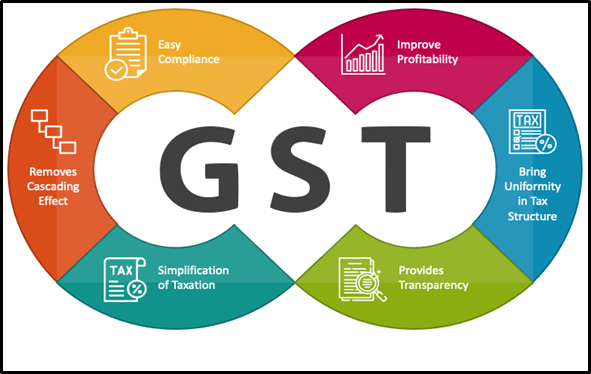CRACKDOWN ON FAKE GST REGISTRATIONS BEGINS AUGUST 16
Syllabus:
GS-2: Governance, Constitution, Polity, Social Justice
Focus:
The news highlights a new nationwide drive starting August 16 to combat fake GST registrations and invoice fraud, aiming to strengthen tax compliance and prevent revenue loss through rigorous verification.
source:wordpress
Nationwide Drive Against Fake GST Registrations:
- Commencement and Duration: The drive starts on 16 August and continues until 15 October.
- Objective: To identify and address suspicious or fake GST registrations.
- Verification Process: Conduct thorough checks to validate the authenticity of GST registrations.
- Action Against Fraud: Immediate suspension and cancellation of GST registrations if entities are found non-existent.
- Focus Areas: Target entities involved in fake invoicing and misuse of input tax credits.
About the Central Board of Indirect Taxes and Customs (CBIC):
Responsibilities:
Tax Administration:
Organisation Structure:
Process to Report Fake GST Registration Access GST Portal:
|
Understanding the Issues with Fake GST Registrations:
- Tax Evasion: Fake registrations facilitate tax evasion by exploiting loopholes in the indirect tax system.
- Invoice Fraud: Entities issue fake invoices to evade taxes and inflate tax credits.
- Economic Impact: Bogus entities distort the market and undermine fair competition.
- Regulatory Challenge: Authorities face difficulties in tracking and addressing fraudulent activities.
- Precedent: Similar issues existed even before the GST regime, continuing to impact the system.
Actions and Consequences:
- Suspension of Registration: If a taxpayer is found to be fictitious, their GST registration will be suspended.
- Cancellation of Registration: Persistent issues will lead to the cancellation of GST registration.
- Blocking of Input Tax Credits: Steps will be taken to prevent the misuse of input tax credits based on fake invoices.
- Recovery of Credits: Efforts will be made to recover input tax credits wrongly used by businesses.
- Identification of Recipients: Businesses that received input tax credits from non-existent taxpayers will be identified.
Technological and Analytical Support:
- Role of Technology: The GST system’s technology-intensive nature aids in detecting and addressing fraud.
- Data Analytics: Robust data analytics help in identifying discrepancies and fraudulent activities.
- Inter-Agency Coordination: Collaboration among various agencies enhances the effectiveness of the drive.
- Economic Formalisation: The formalisation of the economy supports better tracking and regulation.
- Previous Success: A similar drive in the previous year demonstrated the effectiveness of these measures.
Impact on Businesses:
- Transparency Requirement: Businesses are encouraged to maintain transparency and compliance with GST regulations.
- Risk of Unwarranted Attention: Genuine businesses might face scrutiny due to transactions with dubious entities.
- Due Diligence: Importance of verifying the credibility of entities engaged in transactions.
- Invoicing Practices: Businesses should avoid issuing invoices without actual supply of goods or services.
- Proactive Measures: Ensuring compliance can prevent potential issues with tax authorities.
- Government Commitment: The drive underscores the government’s dedication to a fair and clean tax environment.
Historical Context and Future Directions:
- Pre-GST Challenges: Fake invoices were a challenge even before the GST regime.
- Current Strategies: Enhanced data sharing and technological advancements are improving detection.
- Lessons Learned: Insights from previous drives inform current strategies and highlight areas for improvement.
- Future Initiatives: Continued efforts and innovative measures will be necessary to address evolving tax evasion tactics.
- Role of Collaboration: Ongoing cooperation between tax authorities and businesses is key to effective regulation.
Challenges:
- Detection Difficulties: Identifying fake registrations and fraudulent invoices can be complex due to sophisticated evasion techniques.
- Resource Constraints: Limited resources and manpower may hinder the thorough verification of all suspicious entities.
- Data Accuracy: Inaccurate or incomplete data can lead to errors in identifying fraudulent activities.
- Genuine Business Impact: Honest businesses may face disruptions or penalties due to errors in the detection process.
- Evolving Tactics: Fraudsters continually adapt their methods, making it challenging for authorities to stay ahead.
- Inter-Agency Coordination: Effective collaboration among different regulatory bodies can be difficult to achieve.
- Legal Hurdles: Legal complexities and procedural delays can slow down the enforcement actions against fraudsters.
Way Forward:
- Enhanced Technology: Invest in advanced technologies and AI to improve fraud detection and prevention capabilities.
- Increased Resources: Allocate additional resources and manpower for thorough verification and enforcement activities.
- Improved Data Sharing: Foster better data sharing and integration among regulatory agencies to enhance accuracy and efficiency.
- Support for Genuine Businesses: Implement measures to minimise the impact on honest businesses during fraud investigations.
- Ongoing Training: Provide continuous training for tax authorities to keep them updated on evolving fraud tactics.
- Strengthened Collaboration: Promote better coordination and communication between various regulatory bodies.
- Legal Reforms: Streamline legal processes and strengthen laws to expedite enforcement actions and penalties.
Conclusion:
The upcoming drive against fake GST registrations represents a critical effort to enhance tax system integrity, protect genuine businesses, and address sophisticated fraud tactics. Its success will depend on effective implementation and coordination among agencies.
Source: MINT
Mains Practice Question:
Discuss the challenges faced in combating fake GST registrations and suggest measures to enhance the effectiveness of such drives. How can technology and inter-agency collaboration improve tax compliance and fraud detection?




